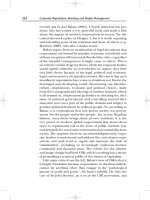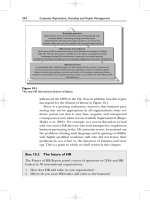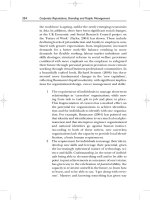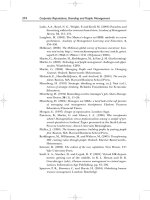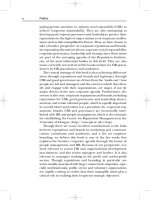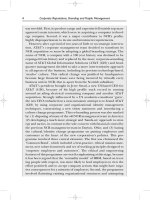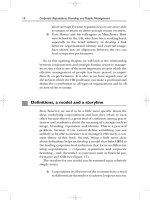Tài liệu Corporate Reputations, Branding and People Management 4 ppt
Bạn đang xem bản rút gọn của tài liệu. Xem và tải ngay bản đầy đủ của tài liệu tại đây (112.57 KB, 10 trang )
above-average Fortune reputation score are more able
to sustain or attain an above-average return on assets.
■ Gary Davies and his colleagues at Manchester Busi-
ness School in the UK, who have been working hard,
especially in the retail industry, to develop a link
between organizational identity and external image,
have shown how an alignment between the two can
lead to superior performance.
So, in this opening chapter, we will look at the relationship
between corporateness and strategic human resource manage-
ment, since this is one of the most important areas in which the
effective management of people has been proved to impact
directly on performance. It is also, as we have argued, one of
the areas in which the HR profession can make a profound and
distinctive contribution to all types of organizations and in all
sectors of the economy.
Definitions, a model and a storyline
First, however, we need to be a little more specific about the
ideas underlying corporateness and how they relate to each
other because there is a great deal of confusion among practi-
tioners and academics about the meaning of concepts such as
image, branding, reputation and identity. This is a practical
problem, because if you cannot define something you are
unlikely to be able to measure it or manage it effectively, a con-
stant theme of this book. Second, being a little more clear
about definitions helps us develop a model that links HRM to
the leading corporate-level indicators that focus on differenti-
ating organizations – corporate reputations and corporate
branding – and, thereafter, to outcomes such as financial per-
formance and CSR (see Figure 1.1).
The storyline for our model can be summed up in relatively
simple terms:
■ Corporations in all sectors of the economy have a need
to differentiate themselves to achieve long-run success,
14 Corporate Reputations, Branding and People Management
HR strategies
High
performance
practices and
degree of
workforce
segmentation
The quality of
individual
employment
relationships
and
employee
behaviour
Corporate
image
Organizational
identity
Corporate
reputation(s)
Communication
strategy and
employer
branding
Organizational
actions and
competences
Corporate
brand
Financial
outcomes
Corporate
identity
The official
rhetoric and
symbols
Corporate
brand or
pledge
Corporate
leadership and
vision
Leadership
vision of who
do we want
to be?
Governance
Corporate
strategy
The optimum
positioning of
the company –
its ideal
identity
The nature
of the HR
function
Competence
Credibility
Figure 1.1
Modelling the relationship between people management, reputations, brands and performance.
which is often measured in financial outcome or in the
public sector, by public good. One of the most import-
ant ways in which they can achieve this aim is to create
and maintain positive reputations for being unique,
which helps build a strong corporate brand, and by
conforming to stakeholder expectations for socially
responsible behaviour and good governance.
■ Corporate vision, leadership and good governance, cor-
porate strategy and the design of an appropriate corpor-
ate identity are the first-level, strategic decisions that
drive this process.
■ These first-level strategic decisions have to be executed
through second-level, effective HR and communica-
tions strategies to create and maintain high quality
employment relationships among individuals, and to
have them identify and engage with the overall corpor-
ate direction and decisions flowing from them.
■ In turn, these individuals help create a unique organ-
izational identity and, in conjunction with leaders, take
actions collectively that reinforce this identity to proj-
ect a positive image to customers, clients and other
stakeholders.
■ How this image is perceived by relevant outsiders (and
by employees) will determine how successful the whole
process has been, but there is good evidence to believe
that alignment between HR strategies, identity, action
and image is critical to strong reputations and corpo-
rate brands.
We have developed this storyline into a model to organize the
rest of the book in Figure 1.1, though you should be aware that
the relationships among these variables are two-way and circu-
lar. So, just as good HR is likely to enhance reputations and
performance, high levels of performance are likely to attract
good human resources in the increasingly global competition
for talent (Florida, 2005).
Finally, in this chapter, we shall begin a preliminary discus-
sion of the significance of corporateness for the HR profession;
what potential does it create and what challenges does it pose
for practitioners?
16 Corporate Reputations, Branding and People Management
Defining corporateness: corporate branding,
identity and corporate reputation
As we noted at the beginning of this chapter, Balmer and
Greyser (2003) have argued that the interest in corporateness
has never been higher, providing a new and powerful lens to
show corporations how they can improve their overall perform-
ance. The promised benefits derived from strong corporate
brands, images and reputations are now being taken seriously by
businesses on a global scale. Witness the various rankings of
companies in the business press, which we have already referred
to, and the attention paid to these rankings by major organiza-
tions. Yet, corporateness also creates a great deal of confusion
because a variety of corporate-level concepts compete for prom-
inence. These include corporate identity, image, branding, repu-
tation and communications. Rather unhelpfully, these concepts
are sometimes used as synonyms for one another and create con-
fusion among the people who have to work with them.
To help shed light on these problems, Balmer and Geyser set
out six questions that explain corporateness. These questions
relate to six distinctive corporate-level concepts (see Table 1.2).
Chapter 1 The importance of the corporate agenda and its links with HRM 17
Table 1.2
What ‘corporateness’ means: six questions and related concepts.
Key question Key concept
What are the corporation’s distinctive attributes? Corporate identity
To whom and what do/should we communicate? Corporate communications
What is our corporate promise or pledge? Corporate branding
What are organizational members’ affinities, or Organizational identity
‘who are we’
How are we perceived as time goes on? Corporate reputation
How are we perceived right now? Corporate image
Source: Adapted from Balmer and Geyser, 2003, p. 4
They have also pointed out that each of these concepts has
been popular with practitioners and academics at different
periods during the past 40–50 years, probably reflecting the
contemporary problems that organizations faced and the vari-
ous disciplinary interests and ambitions of those contributing
to the debate. For example, at the time of writing this book,
corporate branding is a pre-eminent concept, perhaps because
marketing specialists are asserting their claims to ownership of
this field of study and practice, no doubt since it serves their
professional identities and interests to do so. However, from the
perspective of HR, and to repeat our core message, what is com-
mon to all of these concepts is the crucial role of people man-
agement in shaping, making or ‘breaking’ them. As a number
of senior HR academics have commented in a recent, wide-
ranging review of the links between HR strategy and organ-
izational performance, it is not the fact of the existence of
sound HR policies that is important, but how employees actu-
ally experience the intent and implementation of these pol-
icies by senior leaders and their managers (see Special Issue of
the Human Resource Management Journal on HRM and perform-
ance, 2005).
Let’s take a brief look at some of these ideas to help us
sketch out our model in Figure 1.1 that shows how they stand
in relation to each other, and how HR strategies might be used
to influence them. We will spend a little more time on each of
them later in the book but it will help you when we begin to get
into more detail in later chapters to refer back to the overall
picture in Figure 1.1.
Corporate branding
Branding product and services has played a significant part in
the marketing strategy of firms for many years, with a number
of products and services having worldwide recognition and
helping create market values well in excess of book values (see
Table 1.1). We have already highlighted the example of Coca-
Cola. Another good example from the service sector is the MBA,
which is the single most recognizable global brand in educa-
tional services. The classic case of branding lines of products,
however, is associated with Procter & Gamble, the American
multinational that is attributed with ‘inventing’ the branded
18 Corporate Reputations, Branding and People Management
